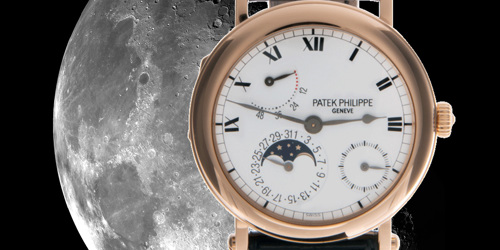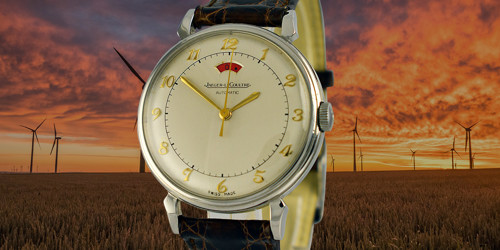Rolex
Close
Patek Philippe
Close
Close
The nearest thing to a fuel gauge on a wristwatch, the power reserve indicator is a real collector's complication. David Duggan explores the history and craftsmanship of the power reserve indicator in his latest in depth article.
One for real collectors, the power reserve indicator is quite an ornamental complication, described by David Duggan as the nearest thing to a fuel gauge on a wristwatch. Here, he explores the history and craftsmanship of the power reserve indicator, and chooses some of his favourite and most collectible models.
A power reserve indicator allows the wearer to see how much power is left in a watch before it needs winding.
It was first introduced in a watch by Breguet in 1933.
Most mechanical watches will run for 35-48 hours without any winding, which means they have a ‘reserve’ of power that lasts for that time when fully wound. Watches with a power reserve display eliminate the guesswork of how long a mechanical watch will run before winding is required.
A power reserve display works much like the fuel gauge in a car and shows a range from ‘full’ to ‘empty.’ Essentially, it lets the wearer know how much tension is left in the watch’s mainspring through a small hand and a correlating scale given in hours. Alternatively, a revolving wheel viewed through an aperture may be used.
On a hand-wound watch, the number of hours indicated by the scale is the amount of time left before it's time to wind, while on an automatic watch, it is the amount of time that the watch will continue to function when it is not being worn.
It works through a series of gears linked to the ratchet wheel (the gear that sits on top of the mainspring barrel) that connects to the power reserve hand. As the crown winds the mainspring, the ratchet wheel turns and begins moving the gear train connected to the indicator hand. A catch disengages that allows the hand to move and then re-engages when the ratchet wheel stops turning (either because the mainspring is full, or the wearer has stopped winding). As the mainspring unwinds over the next few hours, the ratchet wheel slowly turns and activates the gear train linked to the indicator.
Power reserve indicators are particularly useful for automatic watches as simply wearing it (for example while performing a sedentary office job) does not always provide enough physical activity to power the watch. By checking the indicator, you are alerted that more exercise is needed to get the watch up to full power. You might say they help to keep you, as well as your watch, fit!

Power reserve indicators were first introduced into maritime chronometers. The ability to track latitude and longitude relied on the accuracy of the clock, so a power reserve was incredibly useful in reminding the crew when it was time to wind it.
The very first wristwatch to feature a power reserve indicator was made by Breguet in 1933, but it was a prototype and it would be another two decades before Jaeger-LeCoultre introduced the LeCoultre Futurematic. It was the first timepiece without a crown for winding the mainspring. Instead, it had a sliding mechanism on the back to change the time. It was also designed to keep at least six hours of power at all times.
Released a few years later, the LeCoultre Powermatic advanced on the Futurematic concept by focusing solely on the power reserve indicator complication. An aperture at 12 o'clock revealed a coloured disc, which displayed the remaining power left in the mainspring.
A power reserve indicator is an ideal complication for the rich and famous who don’t always wear the same watch, but swap between various different models. By sitting idle in a box and without constant activity of the wearer, an automatic watch’s power reserve begins to dwindle. Having an accurate reading of how much power is left in the mechanism means you’ll always know when to wind it and can avoid looking down at a stopped watch. No wonder rapper Jay-Z loves his Patek Philippe Grandmaster Chime 6300R, while Handmaid’s Tale star Elizabeth Moss favours an IWC Portugieser Chronograph.
The power delivered by the mainspring is not totally constant. Usually, when a watch is fully wound, the power delivered is higher than in the last hours of the spring, meaning the balance spring will be under different pressures from the main spring. This can lead to strange measures while checking your watch accuracy in the end of the power reserve of your watch.

IWC Big Pilot’s Watch Heritage Bronze IW501005 – very close to the original 1940s IWC pilot’s watch in look and feel, this large (46.2mm) bronze-cased timepiece is designed to patina with time, getting slightly darker and adding to the vintage, military aesthetic. Superb legibility is a defining feature of this modern, yet somehow old, timepiece.
Patek Philippe 5054R Moon Power Reserve – the best thing about this timepiece is arguably its value – for under £20,000, the watch combines moonphase complication, date, power gauge and automatic movement. The power gauge clearly displays the extent to which the mainspring is wound and sits unobtrusively on the outskirts of the inner dial without detracting from the simple classicism of the rest of the watch.
Jaeger-LeCoultre Memo Power Reserve – This 1950s model proves that Jaeger-LeCoultre has known how to design an elegant watch with a power reserve indicator for more than half a century, at a time when it was quite rare to see a power reserve indicator on a watch. This unusual feature, along with gold Breguet numerals and the otherwise bare dial, make it a timeless vintage piece.
If you would like advice on buying or selling a power reserve indicator watch, then contact David Duggan Watches or visit us at 63 Burlington Arcade, London.